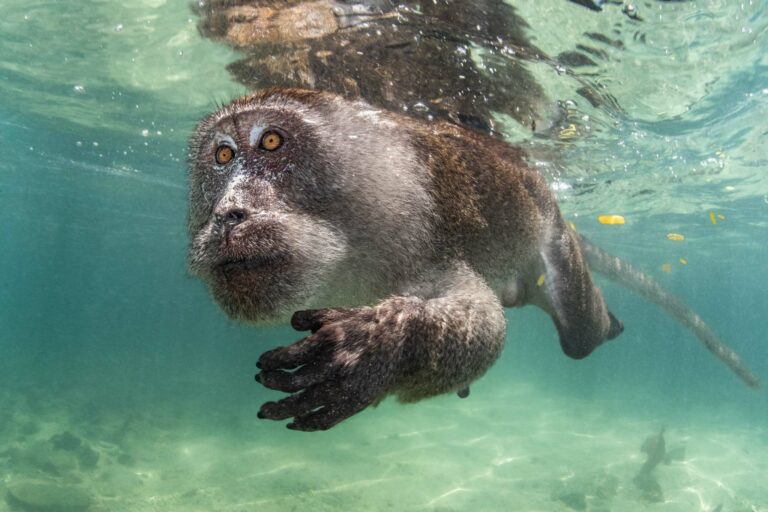The winners of the 12th Ocean Art underwater photo contest have been annnounced, with the Best in Show award going to the winning shot in the Portrait category, Aquatic Primate by Suliman Alatiqi.
This “rare and fascinating” portrait of a male crab-eating macaque was said to have resulted from weeks of planning and documentation by Alatiqi, who also triumphed in the Wide Angle category.
While the underwater photography was engaged in fieldwork in Thailand’s Phi Phi Islands over several weeks, he focused on documenting the animals’ in-water behaviour.
“The macaques have adapted very well to living around the sea and will venture into the water for various reasons, including transportation, scavenging, cooling down and playing,” he says. “Highly efficient swimmers, they can dive for up to half a minute and can cover short distances faster than most humans.
(Taken with a Nikon D850 + 8-15mm AF-S Fisheye f/3.5-4.5E ED lens, Nauticam NA-D850 housing, Sea&Sea YS-D2J strobes, f/18. 1/250th, ISO 640)
“Other extraordinary winners included never-before-seen behaviours, extra-terrestrial blackwater scenes, images that brought hope and solutions for ocean conservation, ingenious lighting techniques, and stunning animal portraits,” commented Nirupam Nigam, editor-in-chief of Underwater Photography Guide (UPG), which organises and oversees what is described as the world’s largest underwater photo contest each year from California.
Sponsors provided what Nigam said was the largest selection of prizes ever awarded in an underwater photo competition: US $120,000-worth of diving holidays at resorts and on liveaboards, as well as underwater photographic gear.
“Although the AI revolution has quickly changed the global photographic landscape, this year’s winners are a testament to humanity’s creative perseverance over machines,” said Nigam, after UPG had introduced new rules against the use of generative AI imagery in its primary categories.
“This year’s competition emphasised the decision-making process for selecting the best underwater photos of 2023, prompting reflection on the nature of a photo, AI and AI tools,” he said. “The winners epitomise pure photography.”
There were 14 categories, with what was previously Underwater Art separated into Underwater Digital Art and Underwater Fashion, with no editing rules to constrain photographers’ imaginations.
The categories were devised to ensure a competitive contest for all levels and disciplines of underwater photography, said Nigam, and the judging panel included photographers Tony Wu, Mark Strickland and Marty Snyderman. Below are the first-placed entries in each category:
Wide Angle
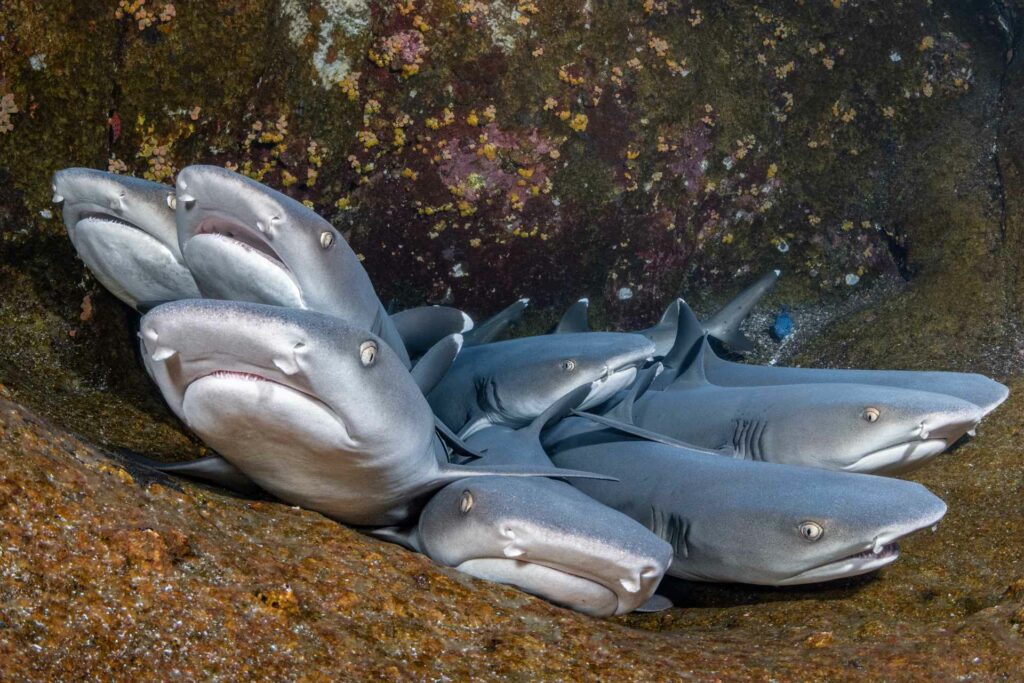
Besides winning the Portrait category and tBest in Show award for his macaque entry, Suliman Alatiqi triumphed in Wide Angle with Bunk Buddies, depicting whitetip reef sharks off the small island of Roca Partida in Mexico.
“Real estate is limited for the many whitetips that live there and they can often be seen bunking together,” he said. “I wanted to get a photo of all of them facing me and, with a lot of patience and a careful approach, I managed to do so.” His prize is a 10-night liveaboard trip in Indonesia from Dive Damai.
(Taken with a Nikon D850 + 8-15mm AF-S Fisheye Nikkor f/3.5-4.5E ED lens, Nauticam D850 housing, Seacam 160D strobes, f/14, 1/250th, ISO 640)
Macro
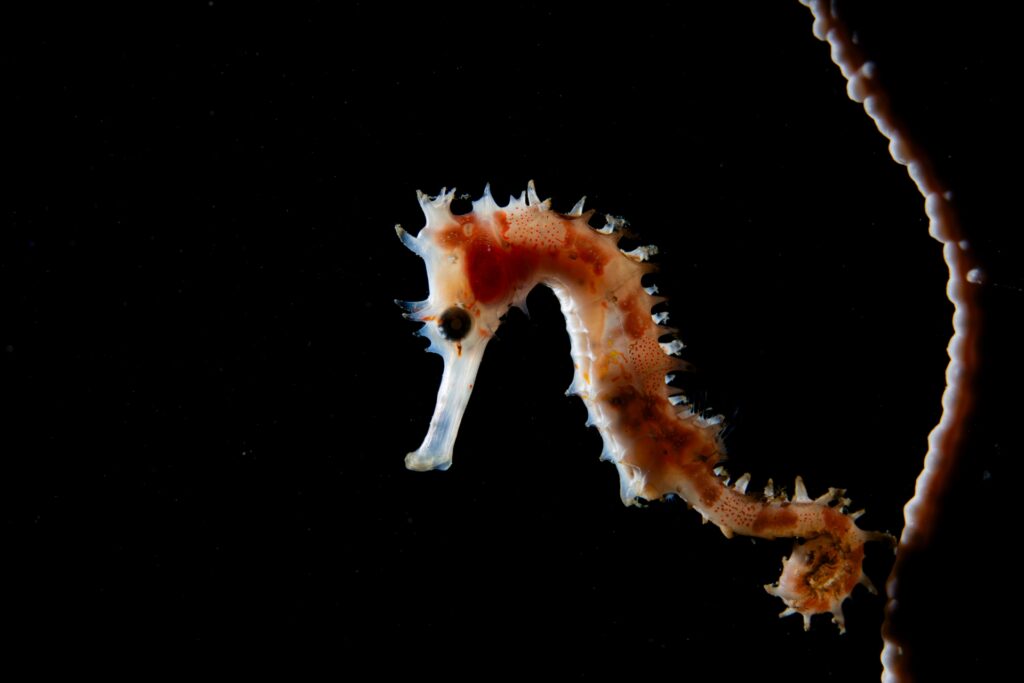
“During the dive, I saw this little subject and I decided to take the picture using a snoot with technical backlighting,” said Alberto Casati of his winning entry Cavalluccio, taken at Puerto Galera, Mindoro in the Philippines. He won a Galapagos liveaboard trip from Andean Travel.
(Taken with a Canon 5D Mark III + Sigma 70mm F2.8 DG Macro Art lens, Sea&Sea housing, Inon Z330 strobes with snoot, f/16, 1/200th, ISO 100)
Marine Life Behaviour
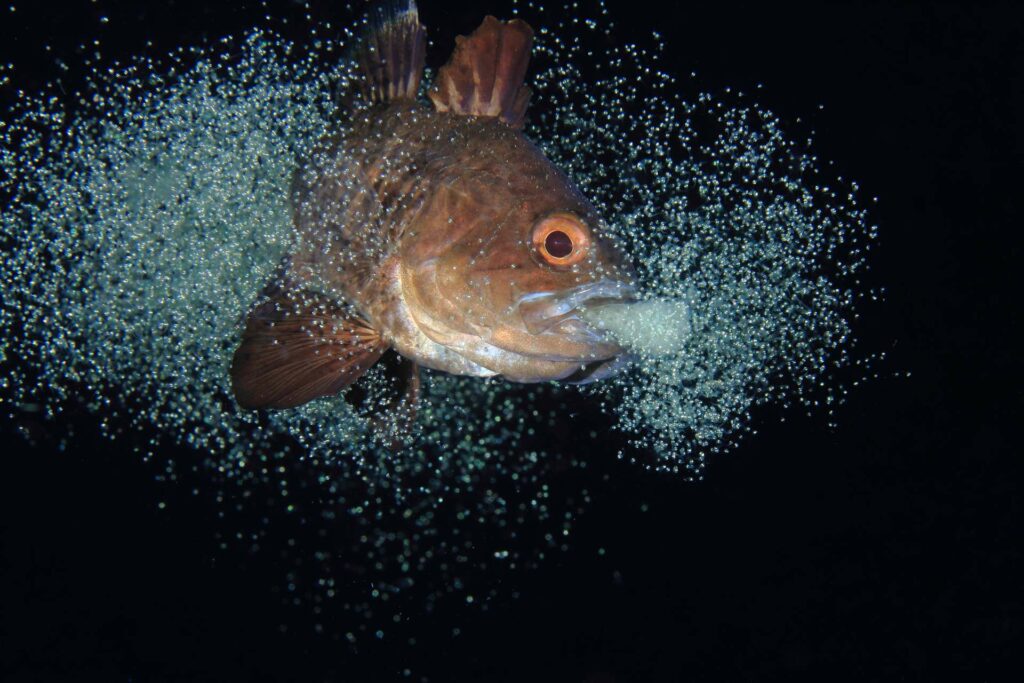
Black cardinalfish live in shallow coastal waters and, as mouth-brooders, the males raise the eggs they receive from females. over the space of about a week Until they hatch they stay still behind a rock, feeding the eggs with fresh seawater.
“After a few observations I could tell when the eggs would hatch,” said Kenji Sato of The Birthday, which he captured in Miura Peninsula, Kanagawa Prefecture, Japan. “Hatching occurs within a few hours after sunset. At the moment of hatching, the father swims upward and spits out the babies in an instant, so it’s difficult to take a picture.”
As many as 20,000 fry are thought to be born in a single hatching. “As soon as the babies hatched, they scattered all over the place. I hope that many of the fry will grow up and survive next year.” The prize was a Sea&Sea YS-D3 Duo strobe.
(Taken with a Canon EOS 7D + EF-S 60mm f/2.8 Macro USM lens, Zillion ZAP7D housing, Inon Z-240, Fisheye FIX NEO Premium strobes, f/7.75, 1/250th, ISO 320)
Cold Water
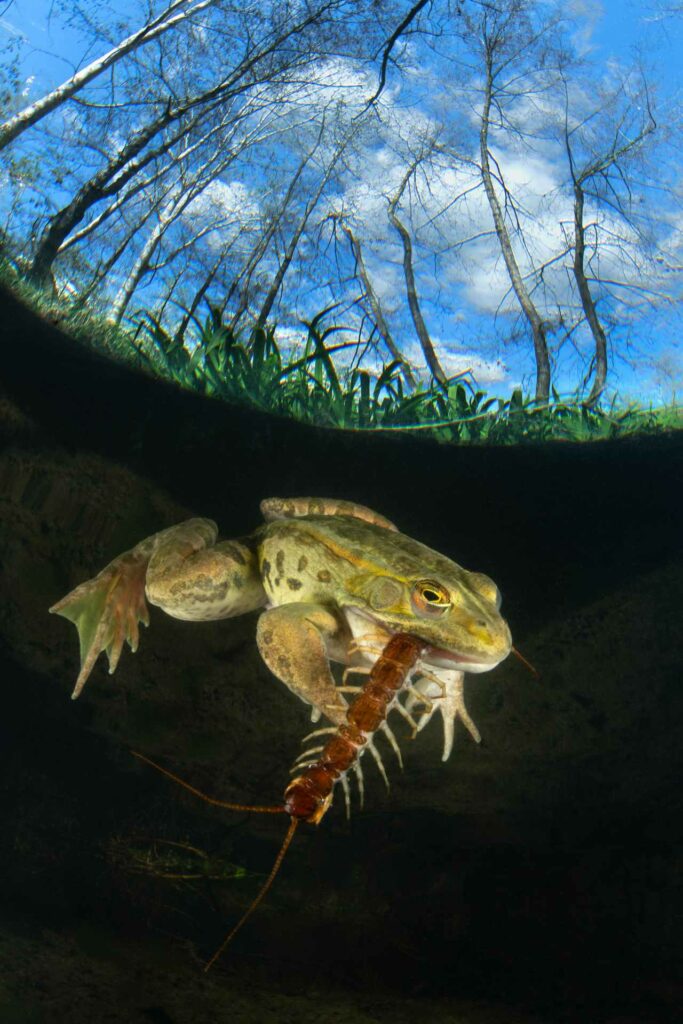
Alessandro Giannaccini’s Lunch Time shows an Italian green frog devouring an insect at Porta Lake, a muddy swamp and protected natural area in Tuscany said to teem with aquatic plants, insects and amphibians.
“I couldn’t believe my eyes as I witnessed this unique and swift scene unfold,” said the Italian photographer. “The entire sequence lasted only a few seconds. In an instant, the frog skilfully captured and consumed the scolopendra, resulting in a sophisticated yet fortuitous photograph!” Giannaccini won an eight-night all-inclusive dive package for two at Magic Oceans Dive Resort in the Philippines.
(Taken with a Nikon D850 + 8-15mm Nikkor lens, Isotta Nikon D850 housing, dual Subtronic Alfa Pro strobes, f/29, 1/320th, ISO 100)
Nudibranch
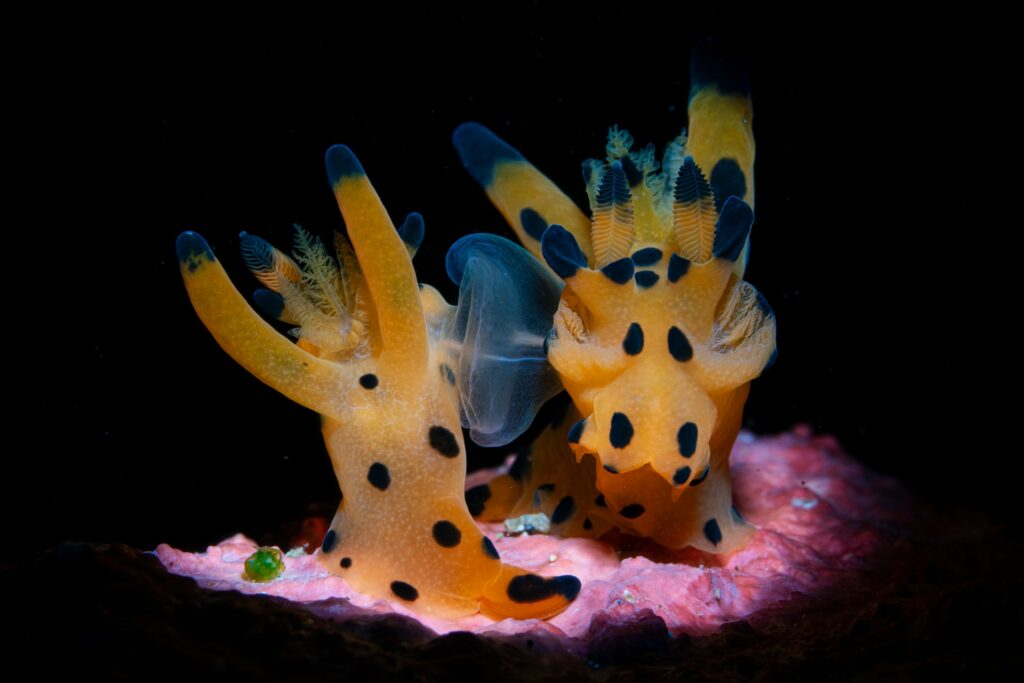
After The Wedding was takn on one of three occasions on which Peter Pogany had dived in Anilao, Batangas in the Philippines over the past two years. “We encountered this species on our first tour and were delighted to find that they were mating. My two diving buddies busied themselves with the nudibranchs, and by the time it was my turn I had no air left.
“I hardly hoped to get a second chance to observe this special event but, on our third tour, I caught them in flagrante.” The shot won him a seven-night dive package at Villa Markisa in Bali, Indonesia.
(Taken with a Sony A7R IV + FE 90mm f2.8 Macro lens, Nauticam A7R IV housing, Backscatter Mini Flash 2 strobe with Backscatter Optical Snoot, f/18, 1/200th, ISO 200)
Blackwater
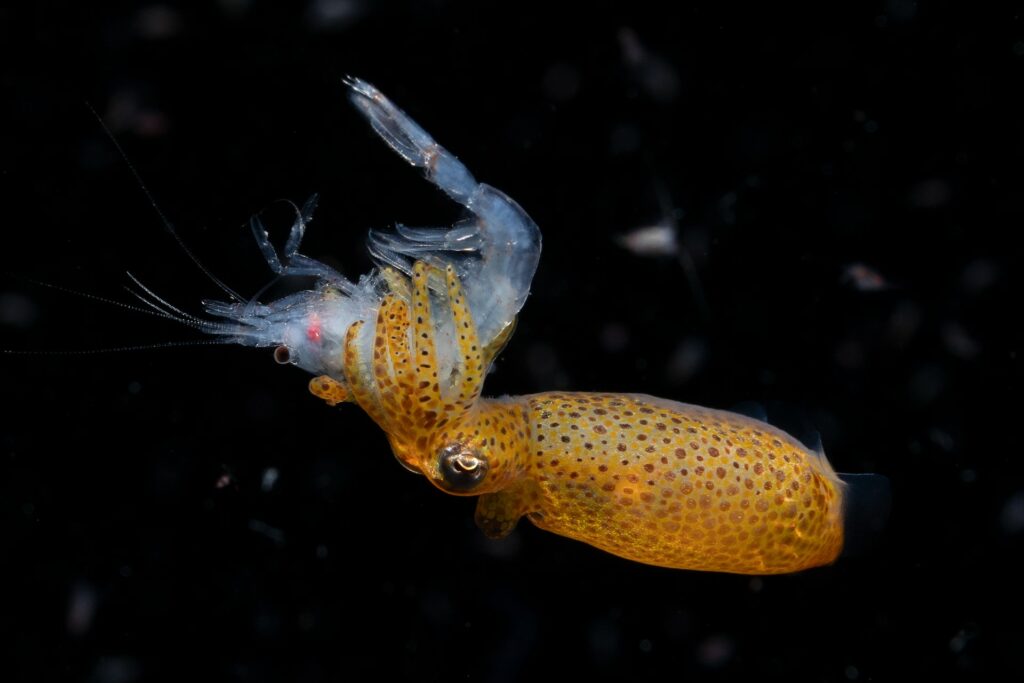
“I collect and photograph floating creatures at night, bonfire style,” says Keigo Kawamura from Japan. “Many squid and shrimp will gather in the underwater torchlight.
“The squid in the photo is known to be the smallest in the world, and the pygmy squid successfully preyed on a shrimp as large as its own body. Pygmy squid eat shrimp by inserting their mouths into the gaps between their shells.” Squid Hunting won Kawamura an Eco Divers 14-night dive package at White Sands Beach Resort in Lembeh, Indonesia.
(Taken with a Canon EOS R6 + EF 24-70mm F4L IS USM lens, Marelux MX-R6 housing, Retra Flash strobes, f/16, 1/200th, ISO 640)
Underwater Conservation
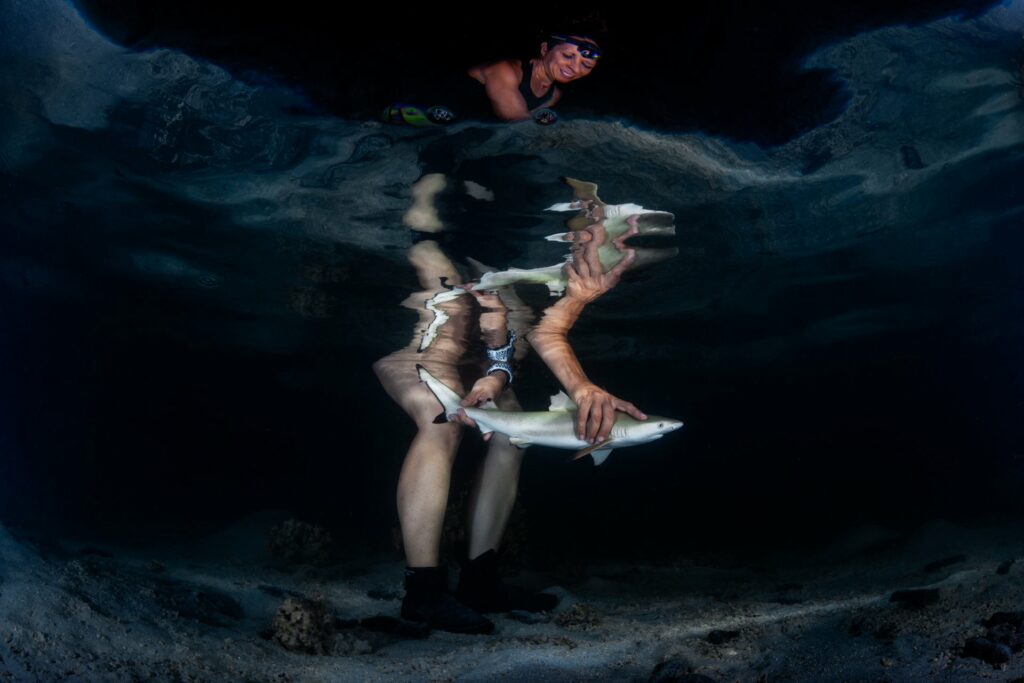
Victor Huertas won the category with this image showing Prof Jodie Rummer releasing a newborn blacktip shark. She had been tagging it and collecting biometric in Mo’orea, French Polynesia.
Prof Rummer leads Physioshark, a research team based at Australia’s James Cook University that investigates the impact of climate change on the physiological performance of newborn sharks in tropical shark nurseries – typically shallow habitats that are highly exposed to rising temperatures and lower oxygen concentrations. The team has found that the sharks are displaying exceptional resilience.
(Taken with a Canon 5D Mark II + Sigma 15mm F2.8 fisheye lens, Aquatica housing, dual Ikelite DS161 strobes, f/14, 1/200the, ISO 160)
Underwater Digital Art

Water Sprite was taken in the clear waters of Florida’s Ginnie Springs by Justin Lutsky, with professional mermaid and underwater performer Abbey Blake as his model. “Everything in this image was shot practically and captured in-camera,” he says. “Abbey wore a mesh bodysuit to which we attached the fairy wings, and together we ventured out into the springs in early January.
“We captured this shot in fairly shallow waters, late in the afternoon after the sun started to dip below the tree-line. I used mostly natural light, using the sun as a backlight, and just a small amount of front fill light from my on-camera strobe.”
Lutsky and his model would submerge simultaneously using a breath-hold technique, capturing multiple photos before resurfacing to review and discuss. “To achieve a comfortable pose on the crevasse’s edge, Abbey had to exhale most of her air to fully descend. The water temperature was a brisk 72°F [22°C], giving us a narrow window to capture the shot before the risk of hypothermia set in.”
The location was also a favourite spot for local cave-divers. “We frequently had to pause our attempts, waiting for divers to pass through the frame. This is where working with someone as talented as Abbey really helps. Her ability to perform under such demanding conditions and limiting time constraints made all the difference in our success in capturing the shot.
“The majority of post-processing done was blending in the harsh, noticeable lines of the bodysuit, as well as overall colour toning and levels adjustments to bring focus to the subject and enhance the overall drama of the underwater landscape.” Lutsky won a Duke of New York liveaboard cruise from Luxury Yacht Maldives.
(Taken with a Sony A7R III + 12-24mm lens, Nauticam housing + Zen DP-230 port, Inon Z330 strobe, f/7.1, 1/200th, ISO 100
Black & White
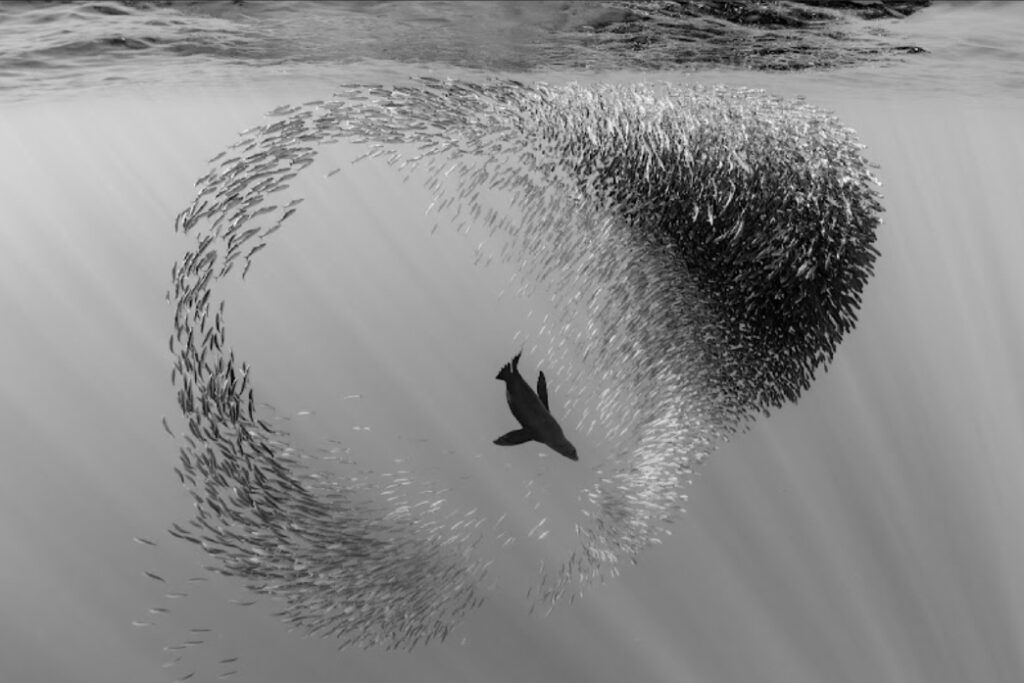
Sea-Lion Playing In Sardine Ball by Joergen Rasmussen reflects the aggregation each November of sardines off Mexico’s Pacific coast, which in turn attracts many predators. The shot was taken at Magdalena, Baja California.
“Working with a local fisherman, we search the deep water offshore near the continental shelf and we spotted a lonely sea-lion,” says Rasmussen. “The sea-lion was chasing the sardines and the ball was constantly changing shape as the sea-lion broke it up.” The prize was a Coralia liveaboard trip in Raja Ampat or Komodo, Indonesia.
(Taken with a Nikon D850 + 13mm RS adapted lens, Seacam housing, ambient light, f/7.1, 1/500th, ISO 400)
Underwater Fashion
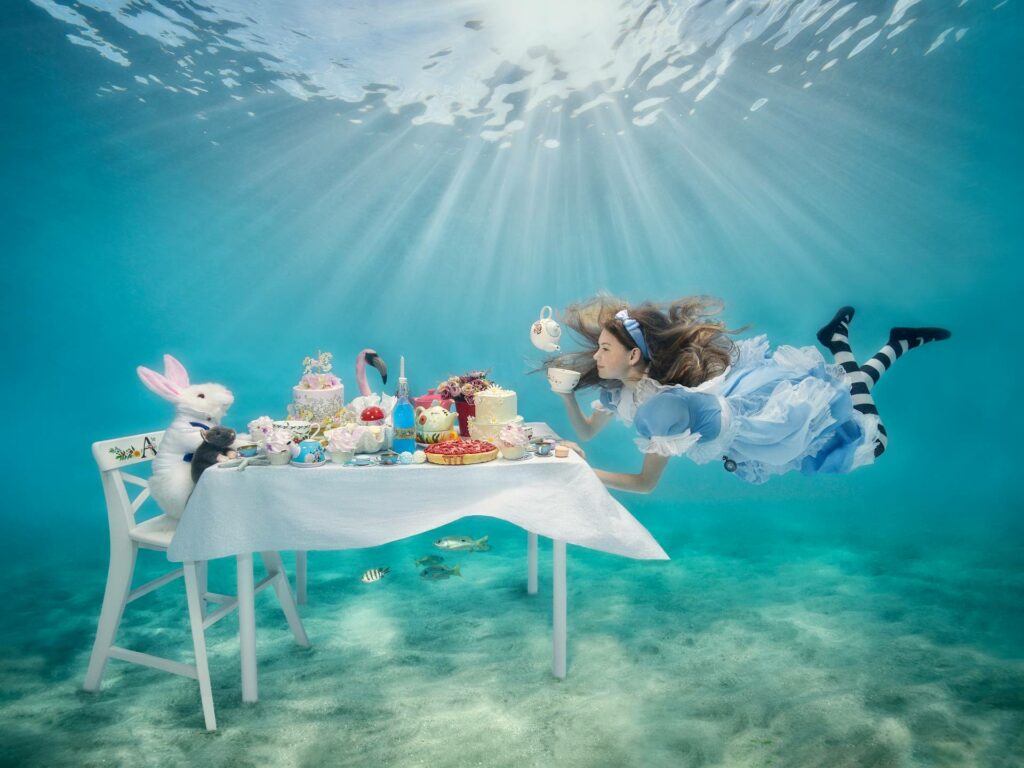
“Once upon a time, in magical, enchanted depths, in the land of the endless water, there lived a girl named Stella. When she was born, her godmother, the Sea Angel, gave her the book Once Upon a Dream in Waterland,” says Czech Republic photographer Lucie Drlikova of her Once Upon a Dream in Waterland project, which she has worked on since 2017.
“While Stella is sleeping, she is dreaming stories from her favourite fairytale book. Alice in Waterland is one of those stories. The project represents a return to my childhood, to the stories that I imagined as a child and these are the stories I wanted to tell one day to my daughter. Unfortunately, she was never born.
“This is the reason I am working on my project, to tell the underwater stories, and in time this project became my baby.”
Of the winning shot Tea Party, Drlikova says: “All the scenes are real, including the food and cakes, which were made from concrete and covered with special coloured foam, photographed under water. Costumes, props and scenes are hand-made by me.” She won a dive cruise with her location of choice in Indonesia and 50% off for a companion on the Oceanic liveaboard.
(Taken with a Nikon Z7II + 17-35mm lens, Nauticam housing, Subtronic strobes, f/7.1, 1/160th, ISO 500)
Compact Wide Angle
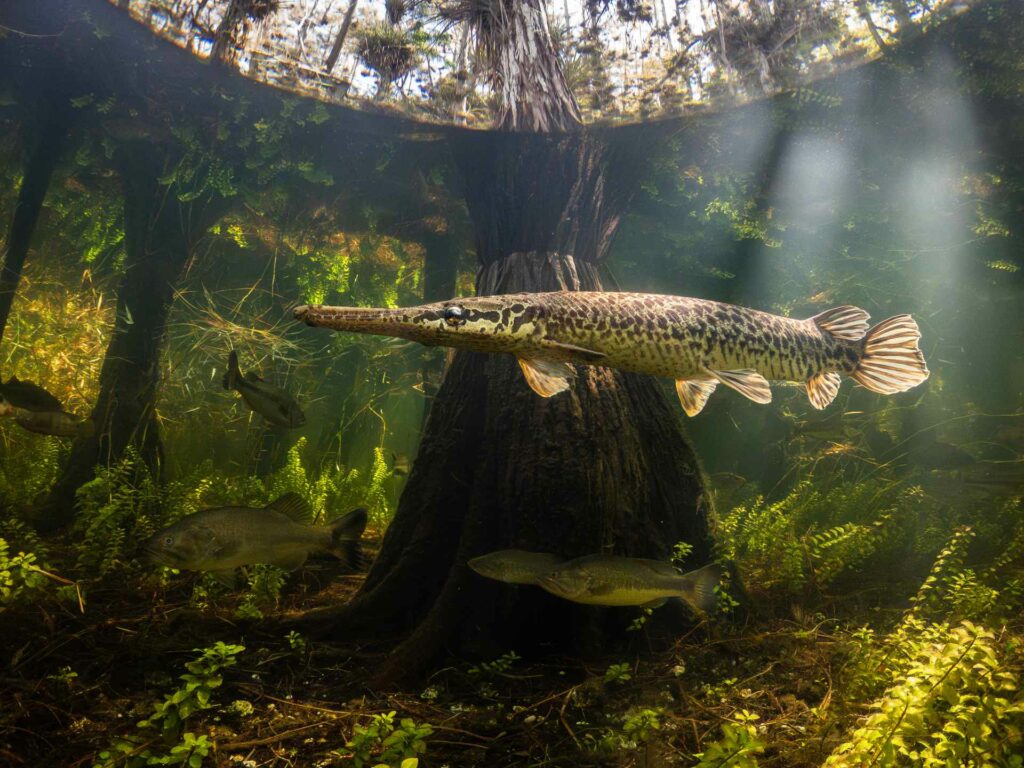
“Exploring new environments, especially seldom-visited ones, is one of the greatest pleasures of underwater photography for me,” says Bryant Turffs, who took The Beauty Of The Swamp in Florida’s Everglades national park, which he describes as “a rightfully foreboding environment, but also one of great beauty and interest.
“To capture this image, I was careful about avoiding risks like alligators in the area that I was snorkelling. Shooting with my GoPro made getting the camera close to my subjects easy.
“In this frame, I sought to capture a beautiful native Florida gar against the backdrop of a cypress dome with light-rays filtering through the trees. As a fish nerd, observing the many beautiful species that call this environment home is another joy.
“This image also features native largemouth bass in the background. Although not featured here, many of my frames from this day of shooting also captured invasive fishes, illustrating just one of the many impacts human actions have had on this imperilled ecosystem.” Turffs won an Ikelite DS-230 strobe with modelling light.
(Taken with a GoPro + AOI Ultra Wide lens, f/2.8, 1/180th, ISO 791)
Compact Macro
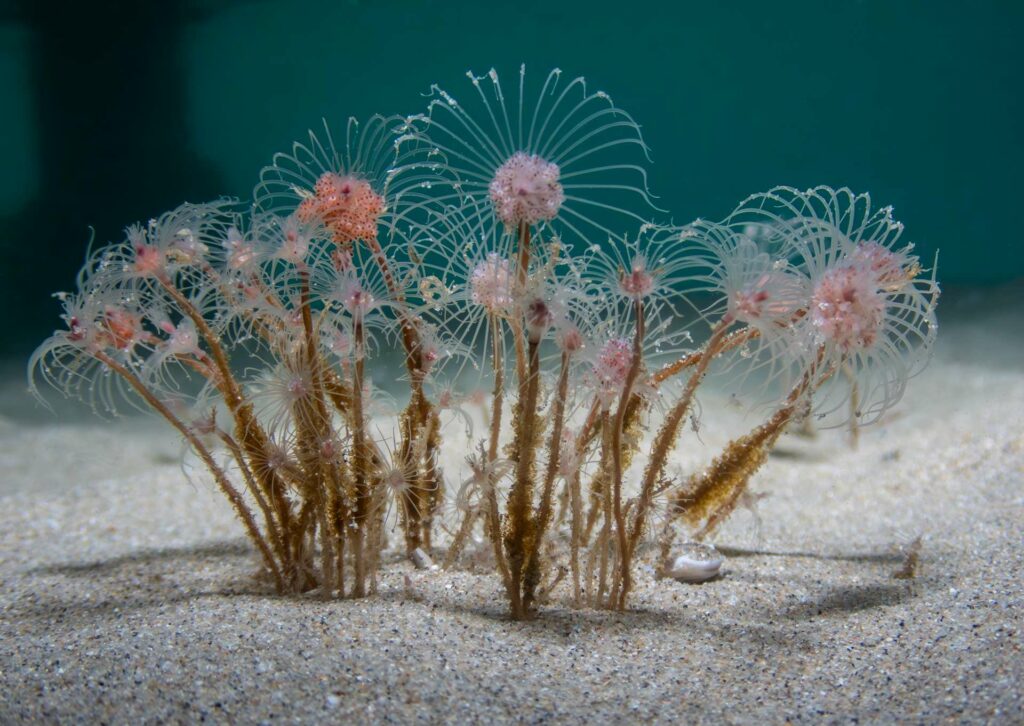
Imogen Manins’ Underwater Fireworks was taken in the shallow waters of Naarm (Port Phillip Bay) on Australia’s Mornington Peninsula, where “sparse colonies of tubular hydroids poke their heads out of the sand in cold, shallow water. There are hundreds of individuals but, at just 4cm or so tall, it’s easy to dismiss these tiny animals, which are endemic to the Great Southern Reef of Australia.
“Each individual here is either male or female and extend their outer tentacles to catch passing plankton. Blairgowrie Pier is a sheltered site, well-known to local divers for the spectacular colours of sessile and invertebrate creatures.
“After 90 minutes in 12°C water, my fingers were becoming numb. Usually, I exit the site at the dive-platform, but this time I began a shore exit, noticing tiny hydroids on the sandy bottom. After inspecting several groups, I chanced on this beautifully arranged colony of ‘underwater fireworks’.
“Trying not to disturb the sand was challenging in this environment. I watched the tentacles move delicately in the water, making small adjustments until I was happy with the composition.” Manins won a seven-night dive package for two from Alami Alor Dive Resort in Indonesia.
(Taken with an Olympus TG6 + Backscatter M52 Wide lens, Olympus PT-09 housing, Sea&Sea YS-D3 strobe, f/13, 1/50th, ISO 200
Compact Behaviour

While GPOs [Giant Pacific Octopuses] are a common sight here in the Pacific North-west, seeing a female nesting is rare enough that when someone does find one, word of mouth spreads quickly,” says Derek Singer, who took Stay-at-Home Mom at Hoodsport in the US state of Washington.
“In this case, my dive-group had heard a couple of nests were found at Sund Rock, an excellent site for finding GPOs in general. Since their dens tend to be in crevices and cuts in the rocks, getting a well-lit and well-composed photo with a large full-frame camera can be difficult (and risky if you’re shooting with a dome).
“Although the female will spend months caring for her eggs, we can never predict when they’ll hatch and she’ll die. I was intent on making the most of my opportunity, since it may have been my only one.
“Therefore, I decided to bring my TG-6 instead of my normal SLR. With the smaller form factor and very short minimum focusing distance, I was confident I could get the camera and the strobes close enough to capture a striking image.
“It turned out to be a good call, because this particular nest was tightly ensconced in a pile of rocks. I captured a series of close-ups of the mama octopus circulating water through her eggs before getting distracted by another GPO wandering out in the open.
“This specific image best portrayed the tightness of the quarters and balanced the mama and her eggs. From the RAW file, my edits were focused primarily on boosting the contrast to make the colours and textures pop.” Singer’s prize was a seven-night dive trip to Anilao in the Philippines with Crystal Blue Dive Resort.
(Taken with an Olympus TG-6, Nauticam housing, Ikelite DS161 strobes, f/18, 1/100th, ISO 100)
All the top three winners and highly commended images in each category can be seen with their back-stories on the the Underwater Photography Guide site. The guide itself features tutorials, technique tips, gear reviews, international workshops and news.
Also on Divernet: Fighting pike stand out in Ocean Art contest, Octopus selfie scoops Ocean Art pool
